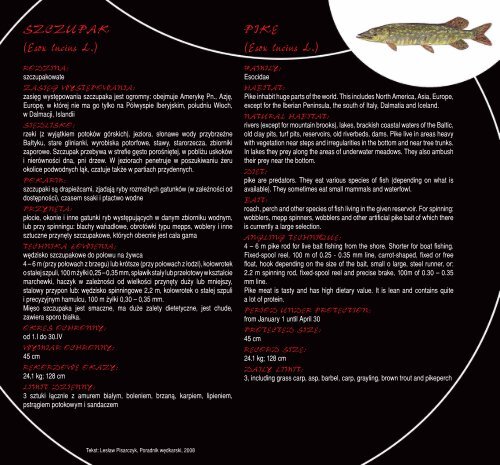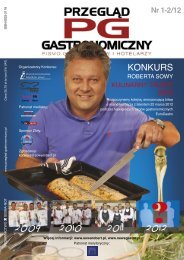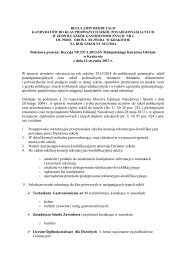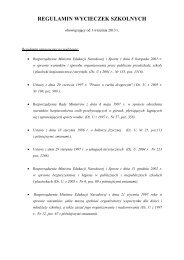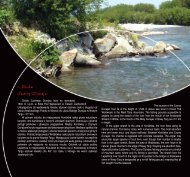You also want an ePaper? Increase the reach of your titles
YUMPU automatically turns print PDFs into web optimized ePapers that Google loves.
SZCZUPAK<br />
(Esox lucius L.)<br />
RODZINA:<br />
szczupakowate<br />
ZASIĘG WYSTĘPOWANIA:<br />
zasięg występowania szczupaka jest ogromny: obejmuje Amerykę Pn., Azję,<br />
Europę, w której nie ma go tylko na Półwyspie Iberyjskim, południu Włoch,<br />
w Dalmacji, Islandii<br />
SIEDLISKO:<br />
rzeki (z wyjątkiem potoków górskich), jeziora, słonawe wody przybrzeżne<br />
Bałtyku, stare glinianki, wyrobiska potorfowe, stawy, starorzecza, zbiorniki<br />
zaporowe. Szczupak przebywa w strefie gęsto porośniętej, w pobliżu uskoków<br />
i nierówności dna, pni drzew. W jeziorach penetruje w poszukiwaniu żeru<br />
okolice podwodnych łąk, czatuje także w partiach przydennych.<br />
POKARM:<br />
szczupaki są drapieżcami, zjadają <strong>ryb</strong>y rozmaitych gatunków (w zależności od<br />
dostępności), czasem ssaki i ptactwo wodne<br />
PRZYNĘTA:<br />
płocie, okonie i inne gatunki <strong>ryb</strong> występujących w danym zbiorniku wodnym,<br />
lub przy spinningu: blachy wahadłowe, obrotówki typu mepps, woblery i inne<br />
sztuczne przynęty szczupakowe, których obecnie jest cała gama<br />
TECHNIKA ŁOWIENIA:<br />
wędzisko szczupakowe do połowu na żywca<br />
4 – 6 m (przy połowach z brzegu) lub krótsze (przy połowach z łodzi), kołowrotek<br />
o stałej szpuli, 100 m żyłki 0,25 – 0,35 mm, spławik stały lub przelotowy w kształcie<br />
marchewki, haczyk w zależności od wielkości przynęty duży lub mniejszy,<br />
stalowy przypon lub: wędzisko spinningowe 2,2 m, kołowrotek o stałej szpuli<br />
i precyzyjnym hamulcu, 100 m żyłki 0,30 – 0,35 mm.<br />
Mięso szczupaka jest smaczne, ma duże zalety dietetyczne, jest chude,<br />
zawiera sporo białka.<br />
OKRES OCHRONNY:<br />
od 1.I do 30.IV<br />
WYMIAR OCHRONNY:<br />
45 cm<br />
REKORDOWE OKAZY:<br />
24,1 kg; 128 cm<br />
LIMIT DZIENNY:<br />
3 sztuki łącznie z amurem białym, boleniem, brzaną, karpiem, lipieniem,<br />
pstrągiem potokowym i sandaczem<br />
PIKE<br />
(Esox lucius L.)<br />
Family:<br />
Esocidae<br />
habitat:<br />
Pike inhabit huge parts of the world. This includes North America, Asia, Europe,<br />
except for the Iberian Peninsula, the south of Italy, Dalmatia and Iceland.<br />
Natural Habitat:<br />
rivers (except for mountain brooks), lakes, brackish coastal waters of the Baltic,<br />
old clay pits, turf pits, reservoirs, old riverbeds, dams. Pike live in areas heavy<br />
with vegetation near steps and irregularities in the bottom and near tree trunks.<br />
In lakes they prey along the areas of underwater meadows. They also ambush<br />
their prey near the bottom.<br />
Diet:<br />
pike are predators. They eat various species of fish (depending on what is<br />
available). They sometimes eat small mammals and waterfowl.<br />
Bait:<br />
roach, perch and other species of fish living in the given reservoir. For spinning:<br />
wobblers, mepp spinners, wobblers and other artificial pike bait of which there<br />
is currently a large selection.<br />
Angling technique:<br />
4 – 6 m pike rod for live bait fishing from the shore. Shorter for boat fishing.<br />
Fixed-spool reel, 100 m of 0.25 - 0.35 mm line, carrot-shaped, fixed or free<br />
float, hook depending on the size of the bait, small o large, steel runner, or:<br />
2.2 m spinning rod, fixed-spool reel and precise brake, 100m of 0.30 – 0.35<br />
mm line.<br />
Pike meat is tasty and has high dietary value. It is lean and contains quite<br />
a lot of protein.<br />
Period under protection:<br />
from January 1 until April 30<br />
Protected size:<br />
45 cm<br />
Record size:<br />
24.1 kg; 128 cm<br />
Daily limit:<br />
3, including grass carp, asp, barbel, carp, grayling, brown trout and pikeperch<br />
Tekst: Lesław Pisarczyk, Poradnik wędkarski, 2008


